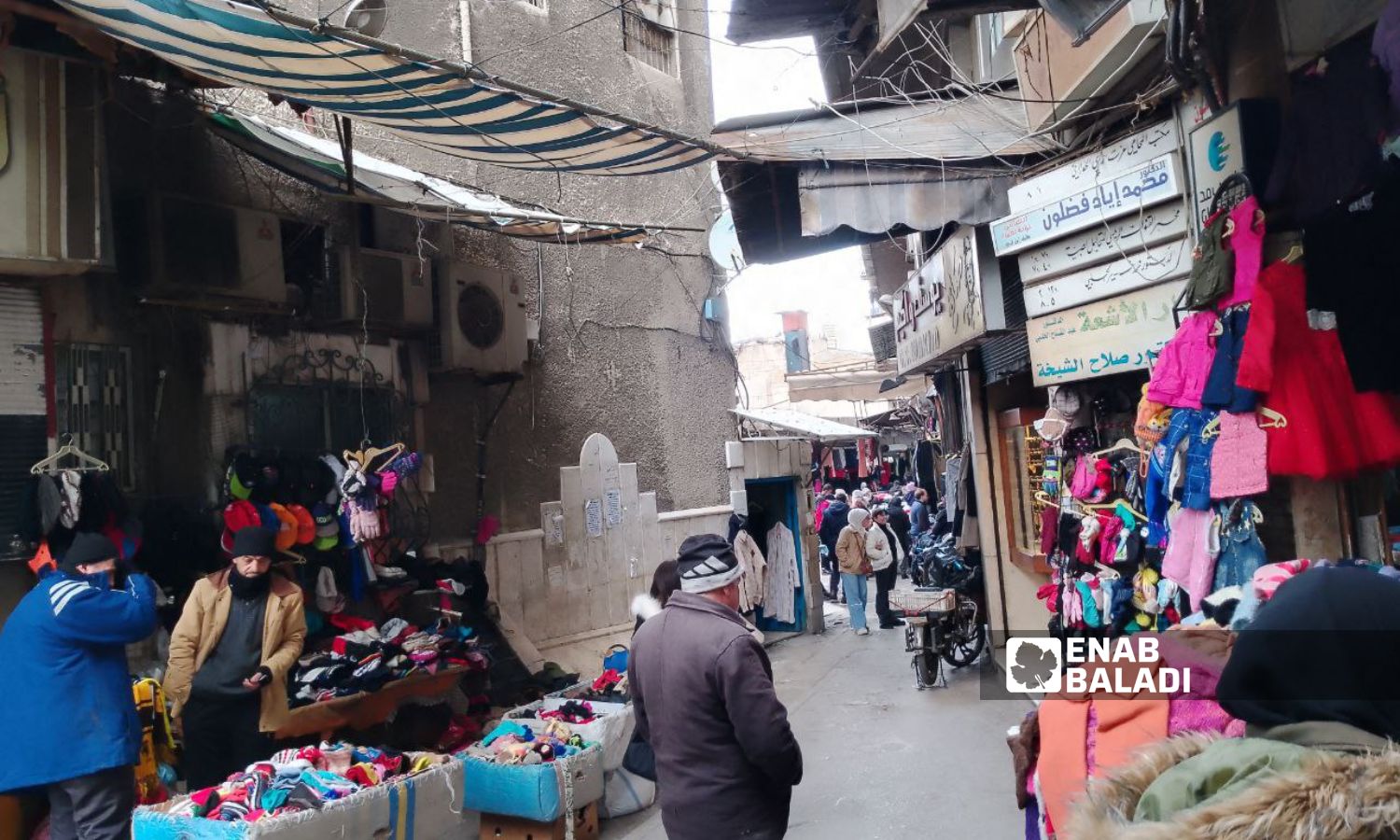



Enab Baladi – Noor al-Haj
“I used to be embarrassed to say that these clothes were second-hand, it doesn’t matter anymore, everyone is wearing from second-hand, we all know even if they don’t say it,” said Abdul Moeen, a thirty-something-year-old young man, expressing a change in attitude towards buying used clothes, traditionally stigmatized among certain social classes.
The situation has changed not just for Abdul Moeen. The two girls, Lama and Syria, said that second-hand clothing has become their main source for clothes, due to the high prices and poor living conditions.
Today, second-hand shops are widespread in all Syrian provinces, offering both summer and winter clothes and shoes, predominantly of European origin, as commonly known.
Second-hand clothes are bundles of used garments collected after sorting, washing, sterilizing, organizing, and being graded, then later sold in markets at cheap prices from countries with higher incomes or booming economies. Some of these clothes are unworn items from out-of-fashion or unsold stock.
“Before the war, I didn’t have to wear second-hand clothes because the local industry was good and cheap, providing options for all classes,” said Abdul Moeen al-Mohammad, displaced from the al-Ghab Plain area in Hama city to the Kuwaiti camp in Harbanoush village, north of Idlib.
He added that second-hand shops weren’t as prevalent before, explaining his shift to buying used clothes due to the high prices of new ones, whether imported or local, and mentioned that quality or public perception no longer mattered to him.
Syria al-Khalid (28 years old) said, before the war, she only wore new, national-brand clothes. But after the war conditions and displacement, saving became a priority, “even if I hated the mere idea that someone else had worn these clothes before me.”
Residing in one of the camps in northern rural Idlib, she mentioned the past “mockery” of those wearing second-hand clothes, but conditions have forced many unwanted changes, emphasizing the importance of modesty.
Girls perhaps felt greater embarrassment than boys, avoiding telling others their clothes were second-hand, according to Lama, a nearly 30-year-old from Latakia.
Since her teens, Lama’s mother bought her and her siblings used clothes when they were more affordable. She would not tell her friends, as it was always perceived that only the poor or needy bought from second-hand centers.
When friends persisted about the store she purchased from, she would avoid the question, telling them it was a gift from another province or even a relative abroad, Lama said.
Lama, who works in a library near Tishreen University in Latakia city, stated that wearing used clothes has become non-embarrassing, sometimes even a source of pride.
Specialists in sociology explain that the economic factors drive the shift in attitude towards acquiring second-hand clothes, lessening its negative perception, and prioritizing needs.
According to social researcher Aisha Abdul Malik, the economic conditions of individuals and the changes post-war are sufficient to alter the perception and judgments traditionally associated with buying used clothing, consequently changing behaviors and increasing acceptance. In tough times, different priorities emerge compared to times of abundance.
Abdul Malik stated, with many Syrians losing jobs or having to change them frequently, and moving out of their homes to rent in other provinces, refugee countries, or camps, a new reality has created more urgent needs for shelter, food, and medicine, necessitating a rearrangement of priorities, with considerations for the balance between expenditure and income, thus seeking alternatives suitable for the new circumstances align well with this perspective.
Firas Shaabo, a Ph.D. in financial and banking sciences, agrees that the general situation post-war, especially economically, contributed to the rise in prices of new clothes and an increased interest in used clothes as a more economical option, particularly when individual incomes have decreased.
Shaabo illustrates the changes in the Syrian dining table post-war, which used to be diverse at each meal. Subsequently, many formerly essential food items began being treated as luxuries due to cost-cutting.
Similarly, in clothes shopping, many people, previously accustomed to buying European or famous international brands, shifted to local or even foreign but used clothes, not new ones. Those who usually bought new local clothes decreased their quality standards, gradually moving from first-grade to second or third, or even lower grades. For many, even new local clothes of a lower quality became expensive, finding in used clothes a more suitable choice.
Lama confirmed that there is a “five-star used clothing”, and it has become ranging in levels, some are from used national products, and the seller knows the customer and their status and tailors the expensive nearly-new merchandise for the richer customer who pays.
She continued that the used clothing stores in areas like Latakia, including al-Ziraa, Project Seven, Republic Street, and Hanano, all indicate that the merchandise is European or at least of high quality, “fashionable” and expensive. Meanwhile, the popular second-hand clothing of Ugarit market is still somewhat stigmatized, and everyone avoids saying they bought from there, including myself.
Social scientist, Aisha Abdul Malik, addressed the broadening audience for used clothing, and the widespread interest in purchasing second-hand clothing across various societal layers, even those who traditionally disdained used clothing customers from lower income people, noting a shift in the derogatory view towards used clothing by middle or better income earners.
She noted that when something becomes widely adopted and nearly collective in behavior, it’s de-stigmatized, with the majority now turning to the used clothing market, breaking those stereotype judgments.
Abdul Malik mentioned that previously, many believed that buying used clothing was confined to less wealthy and poorer families, but in reality this was not the case. The markets and stores of used clothing saw demand from all societal layers, with the wealthy too frequenting these markets to acquire European used pieces that are almost like new, but at lower prices.
if you think the article contain wrong information or you have additional details Send Correction